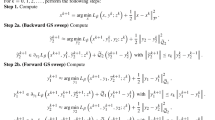Abstract
In recent years, the Fourier domain representation of sparse signals has been very attractive. Sparse fast Fourier transform (or sparse FFT) is a new technique which computes the Fourier transform in a compressed way, using only a subset of the input data. Sparse FFT computes the desired transform in sublinear time, which means in an amount of time that is smaller than the size of data. In big data problems and medical imaging to reduce the time that patient spends in MRI machine, FFT algorithm is not ‘fast’ enough anymore; therefore, the concept of sparse FFT is very important. Similar to compressed sensing, sparse FFT algorithm computes just the important components in the frequency domain in sublinear time. In this work, sparse FFT algorithm is studied and implemented on MATLAB and its performance is compared with Ann Arbor FFT. A filter is used to hash the frequencies in the n dimensional frequency-sparse signal into B bins, where \(B=n/16\). The filter is used for analyzing an important fraction of the whole signal, and therefore, instead of computing n point FFT, B point FFT is computed, and this results in a faster Fourier transform. The probability of success of the implemented algorithm is investigated for noiseless and noisy signals. It is deduced that as the sparsity increases, the probability of perfect transform also increases. If the performances of the algorithm in both cases are compared, it is clearly seen that the performances degrade when there is noise. Therefore, it can be concluded that the algorithm should be improved especially for noisy considerations. The solvability boundary for a constant probability of error is deducted and added to give insight for future studies.











Similar content being viewed by others
References
Arslan, M.T., Bozkurt, A., Sevimli, R.A., Akbas, C.E., Cetin, A.E. Approximate computation of DFT without performing any multiplications: application to radar signal processing. In: 2014 22nd Signal Processing and Communications Applications Conference (SIU), pp. 850–853 (2014). doi:10.1109/SIU.2014.6830363
Bi, X., Chen, X., Li, X., Leng, L.: Energy-based adaptive matching pursuit algorithm for binary sparse signal reconstruction in compressed sensing. Signal Image Video Process. SIViP 8(6), 1039–1048 (2014). doi:10.1007/s11760-014-0614-y
Candes, E., Romberg, J., Tao, T.: Robust uncertainty principles: exact signal reconstruction from highly incomplete frequency information. IEEE Trans. Inf. Theory 52, 489–509 (2006)
Cooke, C.D., Reed, F.K., Prince, L.J., Vann, J.M., Anderson, A.L. An efficient sparse fft algorithm with application to signal source separation and 2d virtual image feature extraction. In: MILCOM 2016–2016 IEEE Military Communications Conference, pp. 396–400 (2016). doi:10.1109/MILCOM.2016.7795359
Donoho, D.: Compressed sensing. IEEE Trans. Inf. Theory 52(4), 1289–1306 (2006)
Gilbert, A., Strauss, M., Tropp, J.: A tutorial on fast Fourier sampling. IEEE Signal Process. Mag. (2008). doi:10.1109/MSP.2007.915000
Gilbert, A., Indyk, P., Iwen, M., Schmidt, L.: Recent developments in the sparse Fourier transform: a compressed Fourier transform for big data. IEEE Signal Process. Mag. 31(5), 91–100 (2014)
Gilbert, A.C., Muthukrishnan, S., Strauss, M.: Improved time bounds for near-optimal sparse Fourier representations. In: Proceedings of SPIE. doi:10.1117/12.615931, https://github.com/annacgilbert/Simple-sublinear-Fourier-sampling (2005)
Gowda, N., Kannu, A.P.: Interferer identification in hetnets using compressive sensing framework. IEEE Trans. Commun. 61, 4780–4787 (2013). doi:10.1109/TCOMM.2013.092813.130196
Gu, Y., Goodman, N.A., Ashok, A.: Radar target profiling and recognition based on tsi-optimized compressive sensing kernel. IEEE Trans. Signal Process. 62(12), 3194–3207 (2014)
Hadi, M., Alshebeili, S., Jamil, K., Abd Al-Samie, F.: Compressive sensing applied to radar systems: an overview. Signal Image Video Process. SIViP 9(Supplement:1), 25–39 (2015). doi:10.1007/s11760-015-0824-y
Hassanieh, H., Adib, F., Katabi, D., Indyk, P.: Faster gps via the sparse Fourier transform. In: MobiCom (2012a)
Hassanieh, H., Indyk, P., Katabi, D., Price, E.: Nearly optimal sparse Fourier transform. In: CoRR. arXiv:1201.2501v2 (2012b)
Hassanieh, H., Indyk, P., Katabi, D., Price, E.: Simple and practical algorithm for sparse Fourier transform. In: SODA (2012c)
Ince, T., Nacaroglu, A., Watsuji, N.: Nonconvex compressed sensing with partially known signal support. Signal Process. 93(1), 338–344 (2013). doi:10.1016/j.sigpro.2012.07.011
Iwen, M.A.: Combinatorial sublinear-time Fourier algorithms. Found. Comput. Math. 10, 303–338 (2010). doi:10.1007/s10208-009-9057-1
Kose, K., Gunay, O., Cetin, E.: Compressive sensing using the modified entropy functional. Digit. Signal Process. 24, 63–70 (2014). doi:10.1016/j.dsp.2013.09.010
Lawlor, D., Wang, Y., Christlieb, A.: Adaptive sub-linear Fourier algorithms. Adv. Adapt. Data Anal. 5(1), 1350003 (2013)
Lustig, M., Donoho, D., Pauly, J.M.: Sparse MRI: the application of compressed sensing for rapid mr imaging. Mag. Reson. Med. 58(6), 1182–1195 (2007)
Ong, F., Pawar, S., Ramchandran, K.: Fast and efficient sparse 2d discrete Fourier transform using sparse-graph codes. In: CoRR. arXiv:1509.05849 (2015)
Pawar, S., Ramchandran, K.: Computing a k-sparse n-length discrete Fourier transform using at most 4k samples and o(k log k) complexity. In: 2013 IEEE International Symposium on Information Theory, pp. 464–468 (2013). doi:10.1109/ISIT.2013.6620269
Rauh, A., Arce, G.: Sparse 2d fast Fourier transform. In: 10th International Sampling Theory and Applications Conference, pp. 57–66 (2013)
Shi, L., Andronesi, O., Hassanieh, H.: Mrs sparse-fft: reducing acquisition time and artifacts for in vivo 2d correlation spectroscopy. In: ISMRM (2013)
Tropp, J.A., Gilbert, A.C., Strauss, M.: Algorithms for simultaneous sparse approximation. part i: greedy pursuit. Signal Process. 86(3), 572–588 (2006). doi:10.1016/j.sigpro.2005.05.030
Acknowledgements
The authors would like to thank Haitham Hassanieh at ECE and CS Systems and Networking Research Group, University of Illinois at Urbana Champaign for his valuable scientific guidance about filters in sparse FFT.
Author information
Authors and Affiliations
Corresponding author
Rights and permissions
About this article
Cite this article
Ermeydan, E.S., Cankaya, I. Sparse fast Fourier transform for exactly sparse signals and signals with additive Gaussian noise. SIViP 12, 445–452 (2018). https://doi.org/10.1007/s11760-017-1177-5
Received:
Revised:
Accepted:
Published:
Issue Date:
DOI: https://doi.org/10.1007/s11760-017-1177-5




